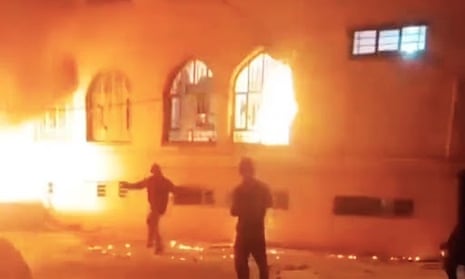Children among dead as Iran sees large protests, strikes
Authorities in Iran are dealing with a three-day surge in protests as the West ramps up pressure over human rights concerns.
Iran protests: family of boy, 9, killed in night of violence blame attack on security forces
Kian Pirfalak was one of several people killed on Wednesday as anger over Mahsa Amini transforms into wider protest against the regime

The family of a nine-year-old boy killed on Wednesday evening by assailants on motorbikes during some of the worst violence in Iran in two months of protests have accused security forces of carrying out the attack.
Kian Pirfalak was one of seven people, including a woman and a 13-year-old child, killed by gunmen in the western city of Izeh.
Authorities blamed the deaths on “terrorists” who “took advantage of a gathering of protesters … to open fire on people and security officers”, according to a report by the official IRNA news agency.
IRNA said eight people were wounded, including three police and two members of the Basij paramilitary force, which is linked to the Islamic Revolutionary Guards.
But in an audio recording tweeted by Radio Farda, a US-funded Persian station based in Prague, a man identifying himself as a family member said security forces were responsible for Kian’s death. “He was going home with his father and was targeted with bullets by the corrupt regime of the Islamic republic. Their car was attacked from all four sides,” the man is heard saying in the recording. A similar allegation was made on Instagram.
The boy’s body was reportedly taken to the family home covered in ice because family members feared if he was sent to the morgue it would be taken by the security forces, as has happened in numerous other cases.
Protesters said members of the Basij paramilitary force were running amok in the city on Wednesday.
Ali Karimi, an Iranian footballer and supporter of the protesters who lives in the United Arab Emirates, wrote on social media: “Kian! We will take back Iran!” Kataneh Afshar Nejad, an Iranian actor, posted footage of herself on Instagram without a hijab condemning Pirfalak’s death.
In a separate attack hours later in Isfahan, two assailants on a motorcycle fired automatic weapons at members of the Basij, killing two and wounding two others, the Fars news agency said.
Protests over the death in custody of Mahsa Amini on 16 September have intensified this week, on the third anniversary of a bloody crackdown on unrest over fuel price hikes. The unrest has been fanned by fury over the brutal enforcement of the mandatory hijab law, but has grown into a broad movement against the theocracy that has ruled Iran since 1979.
On Thursday one protester was killed in Bukan and two in Sanandaj, where mourners were paying tribute to “four victims of the popular resistance” 40 days after they were killed, the Oslo-based Hengaw rights group said.
Footage from Sanandaj on Thursday showed protesters marching down a street filled with bonfires and chanting “death to the dictator”. IRNA reported that a police colonel called Hassan Youssefi had been killed after being stabbed repeatedly in the city.
Late on Wednesday Hengaw had said security forces were accused of killing at least 10 people within a 24-hour period during protests in the cities of Bukan, Kamyaran, Sanandaj and Amini’s home town of Saqez.
Three days of renewed violence had begun on Tuesday when security forces opened fire on people at a metro station in Tehran.
People run for cover as Iranian police open fire during protest at Tehran metro station – video
In a sign that the regime could be preparing the ground for an uptick in repression, official news agencies said Wednesday night’s deaths might be evidence that the protests were turning into an “armed insurrection”. An investigation of the bullets in the bodies of those shot dead is to be held and there is now likely to be a massive propaganda battle in which authorities will argue the protests are the seedbed for what it calls the “Syrianisation” of Iran and a collapse of public order.
As well as the protests, shopkeepers and others have gone on strike in Iran, and videos posted on social media on Wednesday showed shops closed in Tehran’s Grand Bazaar as protesters chanted anti-government slogans. The state claims there is no enthusiasm for the strikes and that organised gangs have been harassing hard-pressed business owners into pulling down their shutters.
The regime’s difficulty, acknowledged by many reformist politicians and academics inside Iran, is that many protesters have long ago stopped taking their news from what they regard as utterly discredited official sources, and instead rely either on internal social media or international Farsi-speaking satellite broadcast channels and websites, such as BBC Persian or Iran International
At least five protesters have now been officially sentenced to death, according to the media centre for the judiciary, one for allegedly setting fire to a government building.
Speaking at the G20 meeting in Indonesia on Wednesday, the French president, Emmanuel Macron, likened recent events in Iran to a revolution.
“Something that has changed [on the ground in Iran] is this revolution of women, young people of Iran, defending universal values like gender equality,” he said. “It’s important to commend the courage and legitimacy of this fight.”
The west appears to be rethinking its entire strategy towards Iran, something Iran’s political establishment is only starting to realise. The internal protests, and evidence that Iran has been supplying Russia with drones to help attack Ukraine, has left advocates of a revival of the nuclear deal struggling for political footing. So far criticism within Iran of the decision to take Russia’s side over Ukraine, given the inevitable wider diplomatic impact, has not been forceful enough to challenge hardliners’ grip on foreign policy.
Agence France-Presse contributed to this report
No comments:
Post a Comment